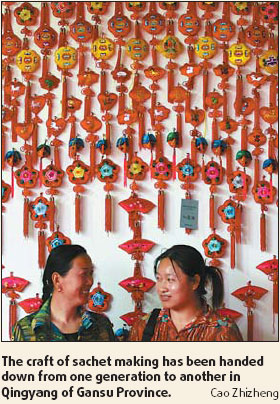He's life is a rich tapestry
He Meiying says that nature has always been an inspiration for her creations since childhood. She spends a lot of time observing the shape of leaves, the color of flowers and the manner of different animals. She weaves this deep passion for the land into sachet making, which she has dedicated herself to since she was a child.
Walking into He's home in Qingyang, Northwest China's Gansu Province, you can see a rich variety of vivid sachets.
On the wall hang several pendent bags that feature a couple of red and blue phoenixes flying over blossoming peonies. On the table lies a silk sachet in the shape of a bowl that is exquisitely embroidered with peaches.
The most eye-catching is a large embroidery piece. Against the red background, He has woven a couplet and an enormous character shou (meaning longevity in Chinese) with silk threads of five flashy colors. If you take a close look, you will find that every stroke is composed of clusters of peonies.
The sachet is also called chu chu in Qingyang. Chu refers to a traditional way of sewing bags, which are fastened with an elastic band.

It is said that thousands of years ago, Qi Bo, author of Huangdi Neijing, or Classic of Internal Medicine, which is believed to be China's earliest classic work on medicine, often carried with him a bag containing herbs that could prevent epidemics and detoxify the snake poison. Qi Bo was born in Qingyang, and so his habit of wearing a scent bag has since been passed down.
The craft has been enriched with the introduction of dazzling embroidery skills. It was a long-standing tradition that girls at the age of 7 or 8 should start to learn needlework and sew sachets.
A lot of local elderly women like 70-year-old He can craft delicate sachets even though they receive little education and don't have solid backgrounds in fine arts. They are born artists with a good sense of colors, design and composition.
He is famous among the locals for her outstanding handicrafts. She is good at painting and has a good memory. Her embroidery creations are also a must dowry for local brides. Ji Qing, He's daughter, still treasures her dowry, a pair of insoles made by He Meiying. Years have passed, yet the locust designs still look vibrant.
"Many people want this pair of insoles. Some have even offered a high price. But I don't want to sell them. They are invaluable," says Ji.
Another reason why He's works are amazingly beautiful is that she produces all the threads herself. She raises silkworms, draws the silk, knits and dyes the threads.
She had made sachets and other embroidery works for others for free till 1996 when she started to sell some of her creations. She says that she doesn't do it for money or people's praises, but for personal contentment.
He has been recently designated a State Intangible Cultural Heritage Inheritor and now both Ji and her daughter are carrying forward the craft.
(China Daily 09/18/2007 page19)














